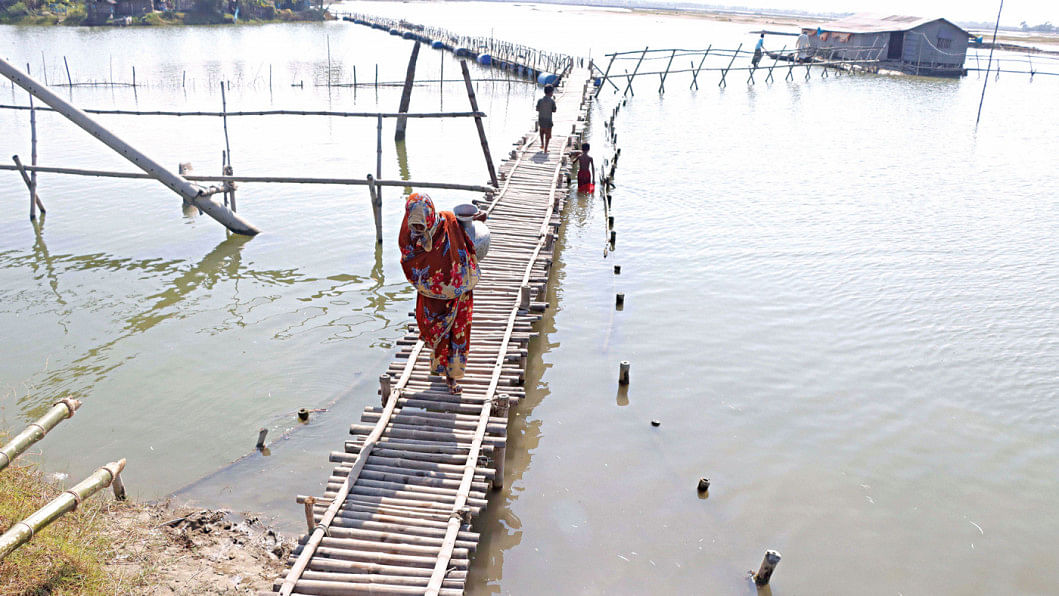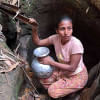Coastal women and their woeful walk for water
At the break of dawn, women of all ages -- daughters, mothers, homemakers -- set out in search for safe drinking water.
They carry not one, but several large water pitchers, balanced on their heads and backs.
Their journey stretches for hours, and often ends in a different village far away from home, where they can finally find some water that is safe to drink.
For many years now, such has been the case for many women in Khulna, Satkhira and Bagerhat. In recent years, rising sea levels and erratic weather patterns have pushed saltwater further inland, contaminating more groundwater sources.

For these women in Southwestern Bangladesh, reaching a source of safe water, however, is only half the battle. There, they join a long line of equally affected women, all waiting their turn to fill their pitchers. The wait can be agonising, stretching into more hours stolen from their day. Finally, after securing their precious water, they begin the long trek back, with fully loaded pitchers on their backs and heads.
I have to walk more than two kilometres to fetch water from a pond. Since I can't make the trip twice a day, I carry a bigger pitcher, which causes back pain and sometimes makes me sick.
This daily struggle comes at a heavy cost. Backache and fatigue are their constant companions.
Walking under the harsh sun everyday takes its toll, leading to frequent bouts of illness.
Yet, they cannot afford to rest. Skipping this daily "pilgrimage" means their families go thirsty. And there is always the risk of waterborne diseases.
The freshwater crisis across the southern coast of Bangladesh affects over 40 lakh people. But it is the marginalised women who bear the brunt of the suffering.
Experts say climate change and shrimp enclosures have not only stolen their clean water, but also amplified the existing inequalities, leaving these women on the frontline of a battle for survival.
Sushma Sarkar, 53, from Dacope upazila of Khulna, said, "I have to walk more than two kilometres to fetch water from a pond. Since I can't make the trip twice a day, I carry a bigger pitcher, which causes back pain and sometimes makes me sick."
"Can you imagine someone carrying a 25-litre pitcher along a four-kilometre road on a sunny day? It's really unbearable for us," she added.
The rich buy water. But this is not an option for people like Sushma. So, they keep their eyes on the sky for rain, which allows them to harvest rainwater.
But climate change has also led to less rainfall, pushing people like Shushma into further despair.

Rina Sarkar, who also struggles to find potable water, said they often drink saline water from the pond directly out of desperation.
"If the government could supply drinking water through pipelines, we would be saved from this curse. They supply electricity through poles and wires, so why not water through pipes?" she asked.
Panchanon Mondal, chairman of Sutorkhali Union Parishad in Dacope, Khulna, said, "Almost 70 percent people in my union lack access to safe drinking water and rely on pond water or other sources."
"Urgent action is needed to alleviate their sufferings, including increased investment in water infrastructure and sustainable solutions to combat salinity intrusion," he added.
According to Dr Md Mehedi Newaz, vice principal of Khulna Medical Hospital, illnesses linked to salinity, like hypertension and kidney ailments, are becoming more common, particularly among women."
Gouranga Nandy, researcher and chairman of the Center for Environment and Participatory Research, said climate change is gradually extending salinity into inland water and soil, threatening coastal biodiversity and human health, especially for women.
CURSE OF SHRIMP ENCLOSURES
The large-scale shrimp cultivation since the 80s has increased soil and water salinity in the coastal region, said Gournanga Nandy.
Shrimp enclosures need saline water to thrive and as a result, salinity intrusion increases with the expansion of shrimp culture. The extent of salinity in groundwater is also increasing because of continuous shrimp cultivation in the fresh agricultural land.
When Sonaban Bibi, 62, got married 46 years ago, there was a pond next to her house, from which she managed to fetch drinking water.
However, some 20 years ago the water of that pond in Betbunia village of Khulna's Paikgacha upazila became unsafe for consumption, due to salt intrusion caused by a nearby shrimp enclosure.
So, for the last 20 years, Sonaban has been fetching drinking water from a pond in nearby Golbunia village, 1.5km away from her house.
Fetching three to four pitchers of water daily for her family of nine is a strenuous task.
"It's a year-round routine, whether it's winter, summer, or rainy season, we need to fetch water from Golbunia," said Sonaban, when she was returning home after fetching water with a big pitcher last week.
Rafuza Begum, a resident of Betbunia, said, "Earlier there were five ponds around our village. Now you can't drink water from any of them. Saline water from shrimp enclosures has contaminated the ponds."
The story is the same for around 34,000 people living in 32 villages of Soladana union.
Abdul Mannan Ghazi, chairman of Soladana union, said, "All 32 villages are saltwater-prone areas. Saltwater shrimps are cultivated everywhere, which has caused the water in the ponds to become salty."
Saikat Mallick, fisheries officer of Paikgacha, said shrimp farming is being conducted on a large scale in 10 unions and one municipal area of the upazila.
"It is the largest saltwater shrimp farming zone in Khulna. This year, 3,940 saltwater shrimp gher [enclosure] is being cultivated on 17,075 hectares of land. Out of this only Soladana Union has 1,037 shrimp enclosures on a plot of 3,495 hecrates," he added.
According to the Khulna Divisional Office of the Water Development Board, local shrimp traders have constructed approximately 3,000 unauthorised sluice gates in the Khulna division, leading to the drilling of at least 10,000 holes in river protection dams. The embankments have significantly weakened, making them prone to breaches under increased water pressure, particularly during cyclones.
The area affected by salt intrusion has expanded dramatically from 833.45 hectares in 1973 to 1,056.26 hectares in 2009.

SALINE WATER AND GENDER INEQUALITY
Men, traditionally paddy field workers, have been forced to migrate to urban areas in search of better opportunities, leaving women to shoulder the increasing burden of household and farm responsibilities.
This out migration has left the women who stayed back alone under increasingly difficult circumstances.
Besides, those men who stay back mostly don't help out their other halves in collecting water, due to gender stereotypes.
Shamima Sultana Shilu, a woman leader and activist in Khulna, said, "Women have to do all the housework. Waterborne diseases are very common for rural women who are in contact with saline water for household chores and other work like netting, fishing, or agricultural tasks."
The migration of men has also left women vulnerable to gender-based violence.
Outsiders, who settled in villages for the shrimp business, have harassed and committed violence against women, especially when they are alone.
Besides, reproductive health problems due to prolonged exposure to saline water are common in coastal Bangladesh, she said.
To escape these health problems, many women undergo surgeries to remove their ovaries. Besides, child marriage is also increasing, Shilu said.
She emphasised the need for societal change. "Men should come forward to assist women and help with household chores."
During a recent visit, this correspondent also spoke to Sonaban Bibi's husband Abdul Majed Dafadar.
He said they got married when he was 22. Sonaban was much younger, although her parents did not mention her exact age at the time of their wedding.
"For 46 years, Sonaban has been fetching water for our family. She now suffers from headaches, hypertension, and breathing difficulties," he said.
"Our two daughters-in-law now help her. I have told my sons to help their daughters, which I regret not doing. I should have been more aware. I don't want the two young girls to end up like my Sonaban," he added.
Contacted, Md Akmol Hossain, executive engineer of Department of Public Health Engineering, told The Daily Star that deep tube wells are not functioning anywhere in 10 unions and one municipal area of the upazila.
There are 42,00 shallow tube wells in all the upazilas, one-third of which are functional, while others are lying idle, he added.
He said they are trying to come up with alternative solutions to potable water such as setting up water tanks for rainwater harvesting, pond sand filters and reverse osmosis.

 For all latest news, follow The Daily Star's Google News channel.
For all latest news, follow The Daily Star's Google News channel. 






Comments